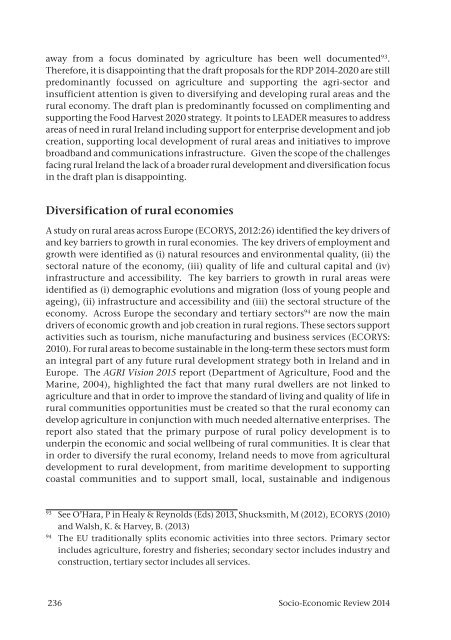2014-04-22 - Socio Economic Review 2014 - Full text and cover - FINAL
2014-04-22 - Socio Economic Review 2014 - Full text and cover - FINAL
2014-04-22 - Socio Economic Review 2014 - Full text and cover - FINAL
You also want an ePaper? Increase the reach of your titles
YUMPU automatically turns print PDFs into web optimized ePapers that Google loves.
away from a focus dominated by agriculture has been well documented 93 .<br />
Therefore, it is disappointing that the draft proposals for the RDP <strong>2014</strong>-2020 are still<br />
predominantly focussed on agriculture <strong>and</strong> supporting the agri-sector <strong>and</strong><br />
insufficient attention is given to diversifying <strong>and</strong> developing rural areas <strong>and</strong> the<br />
rural economy. The draft plan is predominantly focussed on complimenting <strong>and</strong><br />
supporting the Food Harvest 2020 strategy. It points to LEADER measures to address<br />
areas of need in rural Irel<strong>and</strong> including support for enterprise development <strong>and</strong> job<br />
creation, supporting local development of rural areas <strong>and</strong> initiatives to improve<br />
broadb<strong>and</strong> <strong>and</strong> communications infrastructure. Given the scope of the challenges<br />
facing rural Irel<strong>and</strong> the lack of a broader rural development <strong>and</strong> diversification focus<br />
in the draft plan is disappointing.<br />
Diversification of rural economies<br />
A study on rural areas across Europe (ECORYS, 2012:26) identified the key drivers of<br />
<strong>and</strong> key barriers to growth in rural economies. The key drivers of employment <strong>and</strong><br />
growth were identified as (i) natural resources <strong>and</strong> environmental quality, (ii) the<br />
sectoral nature of the economy, (iii) quality of life <strong>and</strong> cultural capital <strong>and</strong> (iv)<br />
infrastructure <strong>and</strong> accessibility. The key barriers to growth in rural areas were<br />
identified as (i) demographic evolutions <strong>and</strong> migration (loss of young people <strong>and</strong><br />
ageing), (ii) infrastructure <strong>and</strong> accessibility <strong>and</strong> (iii) the sectoral structure of the<br />
economy. Across Europe the secondary <strong>and</strong> tertiary sectors 94 are now the main<br />
drivers of economic growth <strong>and</strong> job creation in rural regions. These sectors support<br />
activities such as tourism, niche manufacturing <strong>and</strong> business services (ECORYS:<br />
2010). For rural areas to become sustainable in the long-term these sectors must form<br />
an integral part of any future rural development strategy both in Irel<strong>and</strong> <strong>and</strong> in<br />
Europe. The AGRI Vision 2015 report (Department of Agriculture, Food <strong>and</strong> the<br />
Marine, 20<strong>04</strong>), highlighted the fact that many rural dwellers are not linked to<br />
agriculture <strong>and</strong> that in order to improve the st<strong>and</strong>ard of living <strong>and</strong> quality of life in<br />
rural communities opportunities must be created so that the rural economy can<br />
develop agriculture in conjunction with much needed alternative enterprises. The<br />
report also stated that the primary purpose of rural policy development is to<br />
underpin the economic <strong>and</strong> social wellbeing of rural communities. It is clear that<br />
in order to diversify the rural economy, Irel<strong>and</strong> needs to move from agricultural<br />
development to rural development, from maritime development to supporting<br />
coastal communities <strong>and</strong> to support small, local, sustainable <strong>and</strong> indigenous<br />
93<br />
See O’Hara, P in Healy & Reynolds (Eds) 2013, Shucksmith, M (2012), ECORYS (2010)<br />
<strong>and</strong> Walsh, K. & Harvey, B. (2013)<br />
94<br />
The EU traditionally splits economic activities into three sectors. Primary sector<br />
includes agriculture, forestry <strong>and</strong> fisheries; secondary sector includes industry <strong>and</strong><br />
construction, tertiary sector includes all services.<br />
236 <strong>Socio</strong>-<strong>Economic</strong> <strong>Review</strong> <strong>2014</strong>



